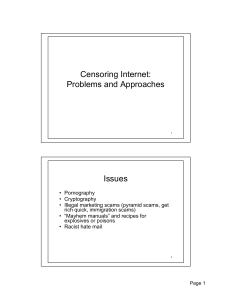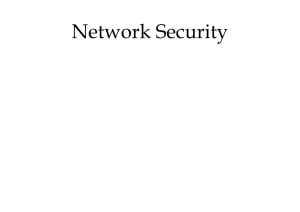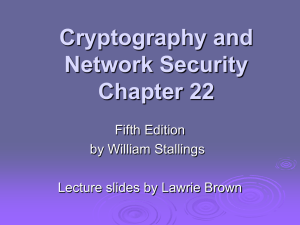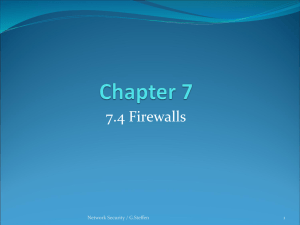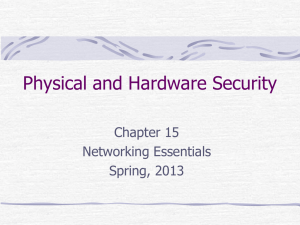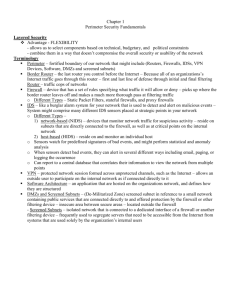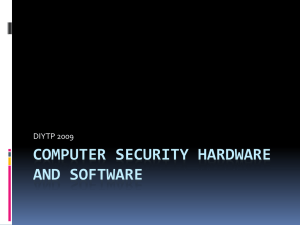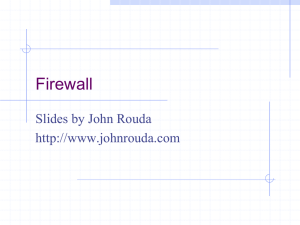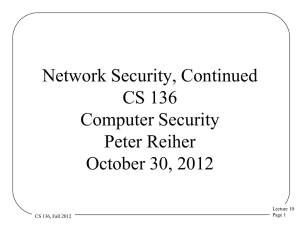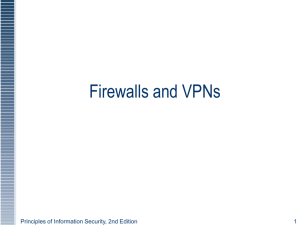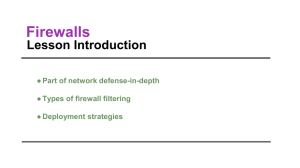Lecture12_Firewalls
advertisement
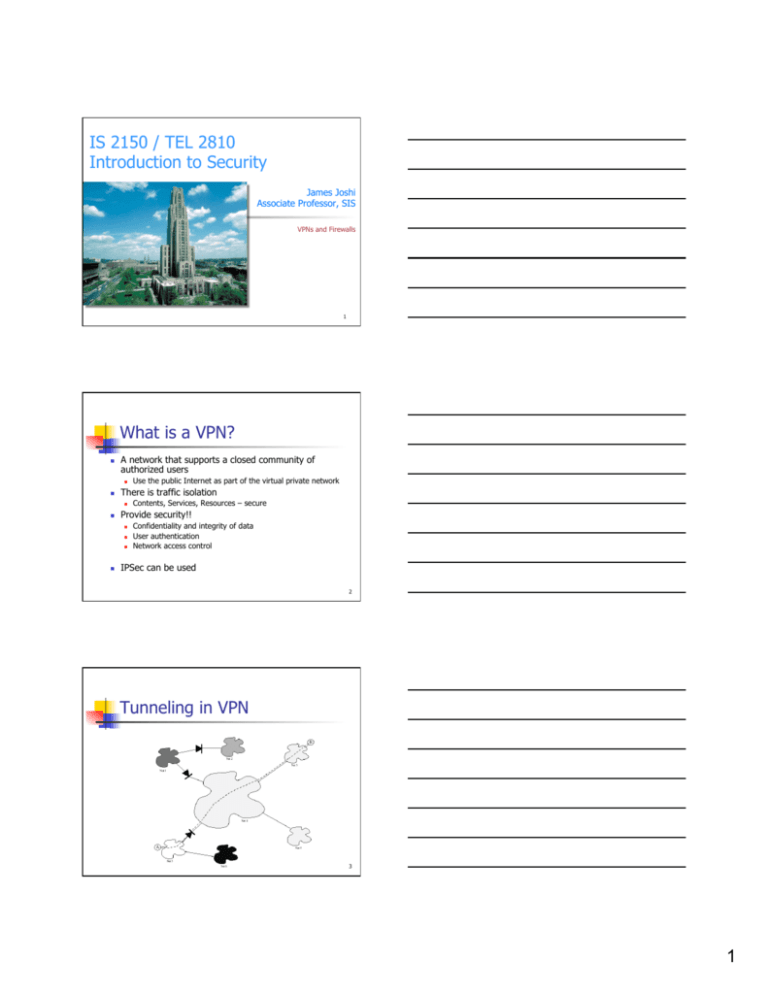
IS 2150 / TEL 2810 Introduction to Security James Joshi Associate Professor, SIS VPNs and Firewalls 1 What is a VPN? n A network that supports a closed community of authorized users n Use the public Internet as part of the virtual private network n There is traffic isolation n Provide security!! n n n n n Contents, Services, Resources – secure Confidentiality and integrity of data User authentication Network access control IPSec can be used 2 Tunneling in VPN 3 1 Perimeter Defense n Organization system consists of a network of many host machines – n n n n the system is as secure as the weakest link Use perimeter defense Define a border and use gatekeeper (firewall) If host machines are scattered and need to use public network, use encryption n Virtual Private Networks (VPNs) 4 Perimeter Defense n Is it adequate? n Locating and securing all perimeter points is quite difficult n n Less effective for large border Mobile connections Inspecting/ensuring that remote connections are adequately protected is difficult n Insiders attack is often the most damaging n 5 Firewalls n Total isolation of networked systems is undesirable n Firewall n n n Use firewalls to achieve selective border control Is a configuration of machines and software Limits network access n n “for free” inside many devices Alternate definition: a firewall is a host that mediates access to a network, allowing and disallowing certain type of access based on a configured security policy 6 2 What Firewalls can’t do n They are not a panacea n n n n Only adds to defense in depth Beware: Can provide false sense of security Cannot prevent insider attack Firewalls act at a particular layer 7 The Development of Firewalls First Generation n Packet filtering firewalls n n are simple networking devices that filter packets by examining every incoming and outgoing packet header Can selectively filter packets based on values in the packet header, accepting or rejecting packets as needed n IP address, type of packet, port request, and/or other elements 8 Second Generation n Application-level firewalls n often consists of dedicated computers kept separate from the first filtering router (edge router) n n n Commonly used in conjunction with a second or internal filtering router - or proxy server Proxy server, rather than the Web server, is exposed to outside world from within a network segment called the demilitarized zone (DMZ), Implemented for specific protocols 9 3 Third Generation n Stateful inspection firewalls, n keep track of each network connection established between internal and external systems n state and context of each packet exchanged (who / when) n can restrict incoming packets by matching with requests from internal hosts n Non-matching packets - it uses ACL rights to determine whether to allow the packet to pass 10 Fourth Generation n A fourth-generation firewall, or dynamic packet filtering firewall, n n n allows only a particular packet with a specific source, destination, and port address to pass through the firewall understands how the protocol functions, and by opening and closing pathways in the firewall an intermediate form, n between traditional static packet filters and application proxies 11 Firewall Architectures n For each type – n n can be implemented in a number of architectural configurations Four architectural implementations of firewalls are especially common: n n n n Packet filtering routers Screened-host firewalls Dual-homed host firewalls Screened-subnet firewalls 12 4 Packet Filtering Routers n Most organizations with an Internet connection n n use a router between their internal networks and the external service provider Limitation n n lacks auditing and strong authentication complexity of the access control lists used to filter the packets can grow to the point of degrading network performance 13 Packet Filtering Router/Firewall 14 Screened-Host Firewall Systems n Screened-host firewall systems n n n combine packet filtering router with a separate, dedicated firewall such as an application proxy server Application proxy examines an application layer protocol, such as HTTP, and performs the proxy services This separate host, referred to as a bastion host, represents a single, rich target for external attacks, and should be very thoroughly secured 15 5 Screened-Host Firewall 16 Dual-Homed Host Firewalls n In this configuration, the bastion host contains two network interfaces: n n n One connected to external network One connected to internal network, requiring all traffic to travel through the firewall to move between the internal and external networks Network–address translation (NAT) is often implemented with this architecture n Converts external IP addresses to special ranges of internal IP addresses 17 Figure 9-7 Dual-Homed Host Firewall 18 6 Screened-Subnet Firewalls (with DMZ) n consists of one or more internal bastion hosts located behind a packet filtering router, with each host protecting the trusted network 19 Summary n n n VPNs Firewalls Firewalls types 20 7
